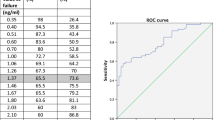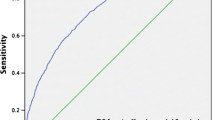Abstract
Aim
The purpose of this study was to evaluate the potential usefulness of [18F]-Choline PET/CT in the restaging of prostate cancer patients, who presented a rising PSA.
Materials and methods
We evaluated 170 prostate cancer patients, previously radically treated, that were referred for restaging with [18F]-Choline PET/CT.
Results
A total of 129 patients (median PSA 4.29 ng/ml at relapse) showed one or more areas of high uptake on PET/CT scan, while 41 patients with a median PSA of 1.07 ng/ml at relapse showed negative PET/CT scans. No false negative was found, while 31 patients were identified as false positive. Specificity of Choline PET/CT in our series was 56.9 %, while sensibility was 100 %. At the time of restaging, a PSA value superior or equal to 1 ng/ml was found to be a statistically significant predictive factor of PET positivity, either at the univariate (p < 0.0001) and at the multivariate analysis (p < 0.0001).
Conclusions
Based on our findings, [18F]-Choline PET/CT is confirmed as a useful diagnostic tool to detect early recurrence, in patients with increasing PSA after primary treatment. However, in case of a mild increase in PSA, positive results must be validated with other techniques, as specificity and positive predictive value of [18F]-Choline PET/CT decrease with the lower values of PSA.


Similar content being viewed by others
References
Breeuwsma AJ, Pruim J, van den Bergh AC et al (2010) Detection of local, regional, and distant recurrence in patients with PSA relapse after external-beam radiotherapy using (11)C-Choline positron emission tomography. Int J Radiat Oncol Biol Phys 77:160–164
Castellucci P, Fuccio C, Nanni C, Santi I, Rizzello A, Lodi F et al (2009) Influence of trigger PSA and PSA kinetics on 11C-Choline PET/CT detection rate in patients with biochemical relapse after radical prostatectomy. J Nucl Med 50:1394–1400
Castellucci P, Fuccio C, Rubello D et al (2011) Is there a role for 11C-Choline PET/CT in the early detection of metastatic disease in surgically treated prostate cancer patients with a mild PSA increase <1.5 ng/ml? Eur J Nucl Med Mol Imaging 38:55–63
Cimitan M, Bortolus R, Morassut S et al (2006) [(18)F] fluorocholine PET/CT imaging for the detection of recurrent prostate cancer at PSA relapse: experience in 100 consecutive patients. Eur J Nucl Med Mol Imaging 33:1387–1398
Contractor K, Challapalli A, Barwick T, Winkler M, Hellawell G, Hazell S et al (2011) Use of [11C]Choline PET-CT as a noninvasive method for detecting pelvic lymph node status from prostate cancer and relationship with choline kinase expression. Clin Cancer Res 17:7673–7683
De Jong IJ, Pruim J, Elsinga PH, Vaalburg W, Mensink HJ (2002) Visualization of prostate cancer with 11C-Choline positron emission tomography. Eur Urol 42:18–23
De Jong IJ, Pruim J, Elsinga PH, Vaalburg W, Mensink HJ (2003a) Preoperative staging of pelvic lymph nodes in prostate cancer by 11C-Choline PET. J Nucl Med 44:331–335
De Jong IJ, Pruim J, Elsinga PH, Vaalburg W, Mensink HJ (2003b) 11C-Choline positron emission tomography for the evaluation after treatment of localized prostate cancer. Eur Urol 44:32–39
Effert PJ, Bares R, Handt S, Wolff JM, Bull U, Jakse G (1996) Metabolic imaging of untreated prostate cancer by positron emission tomography with 18fluorine-labeled deoxyglucose. J Urol 155:994–998
Giovacchini G, Picchio M, Scattoni V et al (2010a) PSA doubling time for prediction of [(11)C] Choline PET/CT findings in prostate cancer patients with biochemical failure after radical prostatectomy. Eur J Nucl Med Mol Imaging 37:1106–1116
Giovacchini G, Picchio M, Coradeschi E et al (2010b) Predictive factors of [(11)C]Choline PET/CT in patients with biochemical failure after radical prostatectomy. Eur J Nucl Med Mol Imaging 37:301–309
Hara T, Kosada N, Kondo T, Kishi H, Kobori O (1997) Imaging of brain tumor, lung cancer, esophageal cancer, colon cancer, prostate cancer and bladder cancer with (C-11)Choline. J Nucl Med 38:250
Hara T, Kosaka N, Kishi H (1998) PET imaging of prostate cancer using carbon-11-choline. J Nucl Med 39:990–995
Heinisch M, Dirisamer A, Loidl W et al (2006) Positron emission tomography/computed tomography with F-18-fluorocholine for restaging of prostate cancer patients: meaningful at PSA < 5 ng/ml? Mol Imaging Biol 8:43–48
Jemal A, Siegel R, Xu J, Ward E (2010) Cancer statistics 2010. CA Cancer J Clin 60(5):277–300
Kotzerke J, Prang J, Neumaier B et al (2000) Experience with carbon-11 Choline positron emission tomography in prostate carcinoma. Eur J Nucl Med 27:1415–1419
Krause BJ, Souvatzoglou M, Tuncel M, Herrmann K, Buck AK, Praus C et al (2008) The detection rate of [11C]Choline-PET/TC depends on the serum PSA-value in patients with biochemical recurrence of prostate cancer. Eur J Nucl Med Mol Imaging 35:18–23
Liu IJ, Zafar MB, Lai YH, Segall GM, Terris MK (2001) Fluorodeoxyglucose positron emission tomography studies in diagnosis and staging of clinically organ-confined prostate cancer. Urology 57:108–111
Oyama N, Akino H, Suzuki Y et al (1999) The increased accumulation of [18F]fluorodeoxyglucose in untreated prostate cancer. Jpn J Clin Oncol 29:623–629
Pelosi E, Arena V, Skanjeti A, Pirro V, Douroukas A, Pupi A et al (2008) Role of whole-body 18F-choline PET/CT in disease detection in patients with biochemical relapse after radical treatment for prostate cancer. Radiol Med 113:895–904
Picchio M, Messa C, Landoni C et al (2003) Value of [11C]choline-positron emission tomography for re-staging prostate cancer: a comparison with [18F] fluorodeoxyglucose-positron emission tomography. J Urol 169:1337–1340
Picchio M, Briganti A, Fanti S, Heidenreich A, Krause BJ, Messa C et al (2011) The role of choline positron emission tomography/computed tomography in the management of patients with prostate-specific antigen progression after radical treatment of prostate cancer. Eur Urol 59:51–60
Pinkawa M, Attieh C, Piroth MD, Holy R, Nussen S, Klotz J et al (2009) Dose-escalation using intensity-modulated radiotherapy for prostate cancer- evaluation of the dose distribution with and without 18F-choline PET-CT detected simultaneous integrated boost. Radiother Oncol 93:213–219
Pinkawa M, Holy R, Piroth MD, Klotz J, Nussen S, Krohn T et al (2010) Intensity-modulated radiotherapy for prostate cancer implementing molecular imaging with 18F-choline PET-CT to define a simultaneous integrated boost. Strahlenther Onkol 186:600–606
Poulsen MH, Bouchelouche K, Gerke O, Petersen H, Svolgaard B, Marcussen N et al (2010) [18F]-fluorocholine positron-emission/computed tomography for lymph node staging of patients with prostate cancer: preliminary results of a prospective study. BJU Int. 106:639–643
Reske SN, Blumstein NM, Glatting G (2008) [11C]choline PET/CT imaging in occult local relapse of prostate cancer after radical prostatectomy. Eur J Nucl Med Mol Imaging 35:9–17
Roberts SG, Blute ML, Bergstralh EJ, Slezak JM, Zincke H (2001) PSA doubling time as a predictor of clinical progression after biochemical failure following radical prostatectomy for prostate cancer. Mayo Clin Proc 76:576–581
Schillaci O, Calabria F, Tavolozza M, Caracciolo CR, Agrò EF, Miano R et al (2012) Influence of PSA, PSA velocity and PSA doubling time on contrast-enhanced (18)F-choline PET/CT detection rate in patients with rising PSA after radical prostatectomy. Eur J Nucl Med Mol Imaging 39:589–596
Schmid DT, John H, Zweifel R et al (2005) Fluorocholine PET/CT in patients with prostate cancer: initial experience. Radiology 235:623–628
Vees H, Buchegger F, Albrecht S, Khan H, Husarik D, Zaidi H et al (2007) (18)F-choline and/or (11)C-acetate positron emission tomography: detection of residual or progressive subclinical disease at very low prostate-specific antigen values (<1 ng/mL) after radical prostatectomy. BJU Int 99:1415–1420
Würschmidt F, Petersen C, Wahl A, Dahle J, Kretschmer M (2011) [18F]fluoroethylcholine-PET/CT imaging for radiation treatment planning of recurrent and primary prostate cancer with dose escalation to PET/CT-positive lymph nodes. Radiat Oncol 44:1–8
Zeisel SH (1981) Dietary choline: biochemistry, physiology, and pharmacology. Annu Rev Nutr 1:95–121
Conflict of interest
The authors have no actual or potential conflict of interest including any financial, personal or other relationships with other people or organizations within that could inappropriately influence their work.
Author information
Authors and Affiliations
Corresponding author
Rights and permissions
About this article
Cite this article
Detti, B., Scoccianti, S., Franceschini, D. et al. Predictive factors of [18F]-Choline PET/CT in 170 patients with increasing PSA after primary radical treatment. J Cancer Res Clin Oncol 139, 521–528 (2013). https://doi.org/10.1007/s00432-012-1354-4
Received:
Accepted:
Published:
Issue Date:
DOI: https://doi.org/10.1007/s00432-012-1354-4




